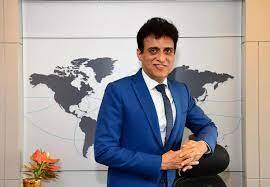As India seeks to become a $5 trillion economy, it will need state-of-the-art, future-proof infrastructure that can support this growth ambition. In a country as large and diverse as India, executing the massive pipeline of infrastructure project is no mean feat.
What this will need is an out-of-the-box innovating thinking and a new approach to infrastructure creation.
A good example of how efficiency from an infrastructure project can be maximized is the Jawaharlal Nehru Port Authority (JNPA), one of India’s premier container handling ports.
JNPA turns around container ships in 22 hours, or 0.9 days, the World Bank’s Logistics Performance Index (LPI) Report, 2023, shows. That’s way faster than peers in Singapore, Malaysia, Indonesia, and the UAE and the US.
JNPA’s import dwell time, a measure of port performance, stood at 19.9 hours in May this year, a Logistics Data Bank report notes – the best for any port in the country. The export dwell time was 65 hours (includes three days free period), behind just one port.
Achievements such as these are in stark contrast to the situation that prevailed just 24 months ago, when Jawaharlal Nehru Port Container Terminal (JNPCT), the container terminal owned and operated by JNPA, was beset with challenges.
The import dwell time of JNPCT was 52 hours while it was 25 hours in the rest of the port.
Financial performance indicators such as berth throughput, operating expenses, and number of employees were alarming. The marketing reach of competing terminals within the port, such as DP World, PSA International, and APM Terminals, were much wider as they opera terminals across the world and had strategic alliances with shipping Iines for driving their cargoes. Their ability to adopt globally accepted best practice through use of technology and offer integrated supply chain solutions was also quite high, all of which resulted in weaning of cargo away from JNPCT.
Indeed, to this day, the popular belief appears to be that major ports in India lag global peers in terms of efficiency.
How did JNPA emerge from this morass?
With crucial policy facilitations from the government and some (creative) deft steering at the port level, the situation was reversed.
The discontinuation of the Tariff Authority for Major Ports, which set tariffs for major ports under the earlier law that governed the state-owned ports, allowed these ports to levy market determined tariffs.
Another important development was the National Monetization Pipeline, devised by NITI Aayog in consultation with relevant line ministries and formulated to align with the mandate for ‘asset monetization’ outlined in the Union Budget.
Asset monetization is built on the philosophy of creating infrastructure through monetization with the objective of tapping private sector investment. The framework is guided by three key imperatives: First, it emphasizes the monetization of rights rather than ownership, ensuring that assets are returned to the government at the end of the transaction lifespan. Second, it prioritizes the monetization of de-risked brownfield assets, offering stable revenue streams to the private sector. Third, it promotes structured partnerships under well-defined contractual frameworks with stringent key performance indicators and performance standards.
JNPA pressed ahead with its plans even though public-private partnerships, including asset monetization, have had a chequered history in India. Based on learnings from other sectors, it ensured the scope of the project was unambiguous and inclusive, e.g., providing a 30-year concession period and a backyard to support operations.
Further, JNPA simplified the bidding parameters, with the royalty to ‘be given to the Authority for every container handled and allowing the freedom to price as per market condition. It also implemented a transparent and time-bound process for concluding the transaction.
Ahead of floating a global bid for the project amid COVID-19 pandemic, a sense of fear had gripped the JNPT staff, many of whom had dedicated time and energy to this asset. For some. Concerns centered around their future both professional and personal. The spread or misinformation by vested interests added to the predicament, with accusations being levelled against the Authority for selling family silver.
Over the ensuing six months, throughout the bidding process, JNPA took steps to safeguard the interests of its workers and other stakeholders. These included introductions of an attractive voluntary retirement scheme which was implemented in a time bound transparent manner and adjustment of remaining workers in new projects like SEZ, Common Rail Yard etc.
The enthusiasm among the bidders was overwhelming. As many as 13 companies/consortiums, including global giants with impeccable credentials participated.
These participants could be primarily classified into four categories -current terminal operators such as DP World, APM Terminals (GTI) and PSA International; shipping lines such as CMA-CGM (tie-up with JM Baxi), MSC, and Wan Hai (with GTI); Indian players such as Adani, JSW, Essar, and All Cargo Logistics; and other international terminal operators such as Q Terminals, TIC (Luxembourg), and ICTSI (Philippines).
The sole criterion for finalizing the bid, i.e., royalty per container handled, far exceeded expectations. The winning bid was Rs4,520 per twenty-foot equivalent unit (TEU) handled at the terminal, exceeding the quotes of the other three bidders who offered above Rs. 4000 per TEU.
Since then, JNPT has successfully monetized its shallow water and coastal berths and the bidding process for its liquid berth is nearly completion, thus becoming the first ‘Landlord Port’. Seven bidders have already submitted their final bid for the liquid terminal project.
The asset monetization has ushered in world-class efficiency.
Today, having set the standards for efficiency across the region, JNPA is undertaking another ambitious project: the development of Vadhavan port, entailing an investment of over $12 billion.
These stellar achievements provide the template for other major ports as well and underline the importance of having an adaptive mindset in order to remain competitive, relevant, and continue playing a crucial role in nation-building.
(Sanjay Sethi, IAS, is the Chairman of Jawaharlal Nehru Port Authority)



